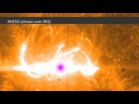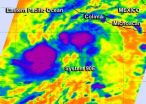(Press-News.org) VIDEO:
Watch the movie to see the wealth of colorful NASA observations of an X-class flare on March 29 -- the most comprehensively observed flare, ever.
BROADCAST QUALITY: http://svs.gsfc.nasa.gov/vis/a010000/a011500/a011522/....
Click here for more information.
On March 29, 2014, an X-class flare erupted from the right side of the sun... and vaulted into history as the best-observed flare of all time. The flare was witnessed by four different NASA spacecraft and one ground-based observatory – three of which had been fortuitously focused in on the correct spot as programmed into their viewing schedule a full day in advance.
To have a record of such an intense flare from so many observatories is unprecedented. Such research can help scientists better understand what catalyst sets off these large explosions on the sun. Perhaps we may even some day be able to predict their onset and forewarn of the radio blackouts solar flares can cause near Earth – blackouts that can interfere with airplane, ship and military communications.
"This is the most comprehensive data set ever collected by NASA's Heliophysics Systems Observatory," said Jonathan Cirtain, project scientist for Hinode at NASA's Marshall Space Flight Center in Huntsville, Ala. "Some of the spacecraft observe the whole sun all the time, but three of the observatories had coordinated in advance to focus on a specific active region of the sun. We need at least a day to program in observation time and the target – so it was extremely fortunate that we caught this X-class flare."
Images and data from the various observations can be seen in the accompanying slide show. The telescopes involved were: NASA's Interface Region Imaging Spectrograph, or IRIS; NASA's Solar Dynamics Observatory, or SDO; NASA's Reuven Ramaty High Energy Solar Spectroscopic Imager, or RHESSI; the Japanese Aerospace Exploration Agency's Hinode; and the National Solar Observatory's Dunn Solar Telescope located at Sacramento Peak in New Mexico. Numerous other spacecraft provided additional data about what was happening on the sun during the event and what the effects were at Earth. NASA's Solar Terrestrial Relations Observatory and the joint European Space Agency and NASA's Solar and Heliospheric Observatory both watched the great cloud of solar material that erupted off the sun with the flare, an event called a coronal mass ejection. The U.S. National Oceanic and Atmospheric Administrations GOES satellite tracked X-rays from the flare, and other spacecraft measured the effects of the flare as it came toward Earth.
This event was particularly exciting for the IRIS team, as this was the first X-class flare ever observed by IRIS. IRIS launched in June 2013 to zoom in on layers of the sun, called the chromosphere and transition region, through which all the energy and heat of a flare must travel as it forms. This region, overall is called the interface region, has typically been very hard to untangle – but on March 29, IRIS provided scientists with the first detailed view of what happens in this region during a flare.
Coordinated observations are crucial to understanding such eruptions on the sun and their effects on space weather near Earth. Where terrestrial weather watching involves thousands of sensors and innumerable thermometers, solar observations still rely on a mere handful of telescopes. The instruments on the observatories are planned so that each shows a different aspect of the flare at a different heights off the sun's surface and at different temperatures. Together the observatories can paint a three-dimensional picture of what happens during any given event on the sun.
In this case, the Dunn Solar Telescope helped coordinate the space-based observatories. Lucia Kleint is the principal investigator of a NASA-funded grant at the Bay Area Environmental Research Institute grant to coordinate ground-based and space-based flare observations. While she and her team were hunting for flares during ten observing days scheduled at Sacramento Peak, they worked with the Hinode and IRIS teams a day in advance to coordinate viewing of the same active region at the same time. Active regions are often the source of solar eruptions, and this one was showing intense magnetic fields that moved in opposite directions in close proximity – a possible harbinger of a flare. However, researchers do not yet know exactly what conditions will lead to a flare so this was a best guess, not a guarantee.
But the guess paid off. In the space of just a few minutes, the most comprehensive flare data set of all time had been collected. Now scientists are hard at work teasing out a more detailed picture of how a flare starts and peaks – an effort that will help unravel the origins of these little-understood explosions on the sun.
INFORMATION: END
NASA telescopes coordinate best-ever flare observations
2014-05-07
ELSE PRESS RELEASES FROM THIS DATE:
Glutamate imaging better than MR spectroscopy in first 3 hours after ischemic stroke
2014-05-07
Leesburg, VA, May 5, 2014—Glutamate imaging reveals ischemic lesions in the first 3 hours after stroke that are not distinguishable in T1-weighted and T2-weighted imaging.
Researchers using chemical exchange saturation transfer (CEST), an emerging MRI technology, have found that using glutamate with CEST shows high spatial resolution in vivo. The finding has the potential to speed diagnosis—and, therefore, treatment—in the critical first hours after a stroke.
"I have been interested in glutamate imaging since its inception," said researcher Zhuozhi Dai of Second Affiliated ...
New study examines premature menopause and effects on later life cognition
2014-05-07
Premature menopause is associated with long-term negative effects on cognitive function, suggests a new study published today (7 May) in BJOG: An International Journal of Obstetrics and Gynaecology (BJOG).
The average age of menopause is around 50 years in the Western World. Premature menopause refers to menopause at or before 40 years of age, this could be due to a bilateral ovariectomy, (surgically induced menopause)or non-surgical loss of ovarian function (sometimes referred to as 'natural' menopause).
The study, based on a sample of 4868 women, used cognitive tests ...
Image-guided peritoneal dialysis catheter placement significantly reduces complications
2014-05-07
Leesburg, VA, May 7, 2014— Patients undergoing peritoneal dialysis catheter placement via fluoroscopy and ultrasound-guidance experienced significantly fewer complications at 1 year post-insertion than did patients whose catheters were placed laparoscopically.
The first of two study groups received catheters using fluoroscopy and ultrasound guidance under conscious sedation by interventional radiologists. In the second group, the catheters were inserted using laparoscopy under general anesthesia by surgeons.
"Our results showed that the overall complications at 1 ...
Iterative reconstruction techniques reduce radiation dose for pediatric brain CT
2014-05-07
Leesburg, VA, May 7, 2014—A study conducted at Massachusetts General Hospital and Harvard Medical School found that estimated radiation doses are substantially lower for pediatric CT exams of the brain that used an adaptive statistical iterative reconstruction technique (ASIR) compared to those that did not use ASIR. The researchers found that the brain and salivary gland doses were much lower for ASIR-enabled exams compared to those without ASIR technique. However, no differences in the estimated organ doses were found for the thyroid gland, skeleton, and eye lenses across ...
Nonscreened patients with breast cancer need more treatment than screened patients
2014-05-07
Leesburg, VA, May 6, 2014—Screening 40- to 49-year-old women for breast cancer has additional benefits beyond the proven decrease in mortality rate. Patients screened with mammography are statistically less likely to undergo chemotherapy, avoiding the associated toxic morbidities. Screening mammography also helps identify a subset of patients at increased risk of breast cancer by diagnosing high-risk lesions.
The majority of high-risk lesions identified in a retrospective chart review were found in screened patients. Identifying patients at high risk may allow for the ...
Overestimation of radiation exposure may keep women from critical screening
2014-05-07
Leesburg, VA, May 5, 2014—Misinformation and misunderstanding about the risks associated with ionizing radiation create heightened public concern and fear, and may result in avoidance of screening mammography that can detect early cancers.
In a study to determine the baseline understanding of the radiation associated with mammography among patients presenting for initial or follow-up imaging, women were asked to rate the amount of radiation received in a single mammogram as being significantly less, slightly less, about the same, slightly more, or significantly more compared ...
EARTH Magazine: Naturally occurring methane found in groundwater in New York
2014-05-07
Alexandria, Va. – Since hydraulic fracturing operations began in the Marcellus Shale region, debate has raged over whether drilling operations are causing high levels of methane in drinking-water wells. But few systematic scientific studies have been published to date, so it's unknown if high methane levels are natural or the result of contamination from nearby gas wells. Now, a new study is adding some much-needed baseline data for methane levels in groundwater in New York. The results suggest that at least in some cases methane occurs at naturally high levels in groundwater.
Read ...
NASA watching year's first tropical low headed for southwestern Mexico
2014-05-07
There's a tropical low pressure area in the Eastern Pacific Ocean today, about 8 days before the official Eastern Pacific hurricane season begins. NOAA's National Hurricane Center is giving it a 50 percent chance of becoming a tropical depression in the next two days, and NASA's Aqua satellite passed overhead to gather infrared data on it.
NASA's Aqua satellite passed over developing tropical low pressure system 90E on May 8 at 08:41 UTC (4:41 a.m. EDT) and infrared data from the Atmospheric Infrared Sounder (AIRS) instrument aboard, showed that some of the thunderstorms ...
Automated CT dose-tracking software effectively monitors dosage in a clinical setting
2014-05-07
Leesburg, VA, May 5, 2014—Dose-tracking software provides effective and easy monitoring of radiation dose exposure in a busy academic practice, according to research conducted at Massachusetts General Hospital.
For commonly ordered abdominal CT exams, iterative reconstruction techniques enabled approximately 50 percent radiation dose reduction compared to the national averages reported in the Dose Index Registry*.
"A busy practice with diverse CT technology and remote scanner locations encounters challenges in assessing institutional performance in lowering radiation ...
Breast tomosynthesis after screening mammography reduces need for ultrasound, biopsies
2014-05-07
Leesburg, VA, May 5, 2014—Breast tomosynthesis in the diagnostic workup for one- or two-view focal asymmetry detected at screening mammography resulted in less use of ultrasound, fewer biopsies, and higher positive predictive value for cancer than when diagnostic exams involved only 2D mammography, according to a study conducted at the University of Virginia.
"Tomosynthesis has been evaluated in screening populations and been shown to decrease recall rates," said researcher Brandi Nicholson, "but studies in the diagnostic setting are lacking."
Five hundred thirty ...


